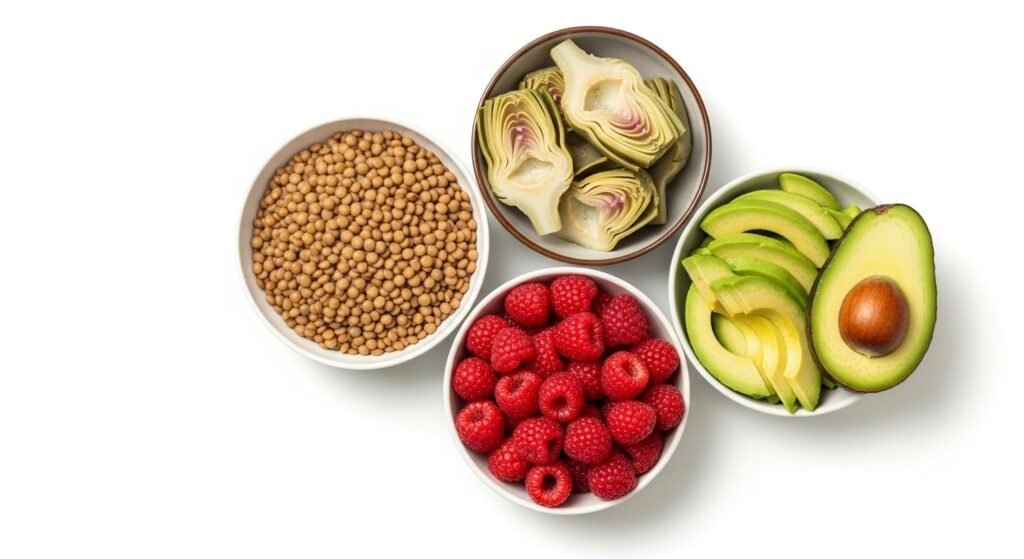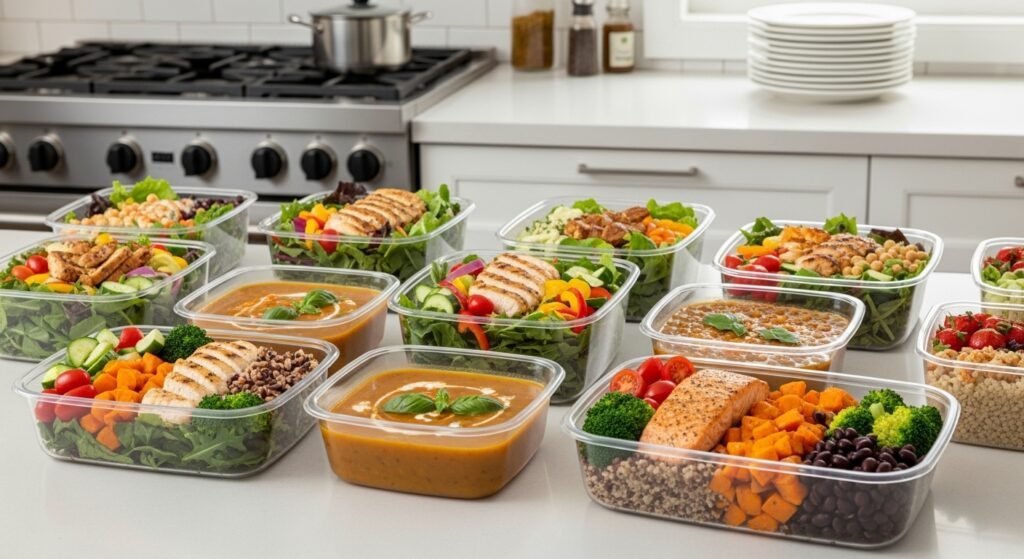Page Contents
ToggleAre you dealing with sluggish digestion, irregular bathroom visits, or that uncomfortable bloated feeling that seems to linger? If you’re between 30 and 60, these issues might be your body’s way of asking for more fiber. The good news is that high fiber foods can transform your digestive health naturally, without relying on supplements or medications. Let’s explore how these powerhouse foods work and which ones deserve a spot on your plate every day.
Understanding High Fiber Foods and Their Benefits
High fiber foods contain plant-based carbohydrates that your body can’t fully digest. Instead of breaking down like other nutrients, fiber passes through your system relatively intact, providing incredible benefits along the way. Think of fiber as your digestive system’s best friend – it keeps things moving smoothly while feeding the beneficial bacteria in your gut.
There are two main types: soluble fiber dissolves in water to form a gel-like substance that helps lower cholesterol and blood sugar, while insoluble fiber adds bulk to stool and helps food pass more quickly through your digestive tract. Most whole foods contain both types, making them particularly valuable for overall health.
If you’re looking for ways to strengthen your gut beyond food alone, check out our PrimeBiome Review 2025, where we cover a probiotic designed to support digestion, reduce bloating, and improve nutrient absorption.
Best Sources of Dietary Fiber
Finding the best sources of fiber doesn’t require exotic ingredients or expensive supplements. Nature provides abundant options that fit easily into your daily meals. Legumes lead the pack – a single cup of cooked lentils delivers about 15 grams of fiber, nearly half your daily needs.
Top fiber champions include:
- Beans and lentils: 12-15 grams per cup
- Artichokes: 10 grams per medium artichoke
- Raspberries: 8 grams per cup
- Whole grains: 6-8 grams per cup (cooked)
- Avocados: 10 grams per whole avocado
- Chia seeds: 10 grams per ounce

Vegetables like broccoli, Brussels sprouts, and sweet potatoes provide 5-6 grams per serving while adding valuable nutrients. The key is variety – different foods provide different fiber types and additional health benefits.
For people who experience bloating or irregularity even with a high-fiber diet, supplements like the one in our PrimeBiome Review 2025 can help restore gut balance.
Daily Requirements by Age and Gender
Meeting your daily requirements becomes increasingly important as metabolism slows with age. The Institute of Medicine recommends specific amounts based on age and gender to optimize digestive health and disease prevention.

Current guidelines suggest:
- Men 50 and younger: 38 grams daily
- Men over 50: 30 grams daily
- Women 50 and younger: 25 grams daily
- Women over 50: 21 grams daily
Curious about how probiotics can work alongside fiber for even better results? Our PrimeBiome Review 2025 explains how a targeted formula can complement your diet to maximize digestive health.
Health Benefits Beyond Digestion
While digestive health improvements are often the first noticeable changes, the health benefits of adequate fiber intake extend throughout your body.
Research shows that people who consume recommended fiber amounts have:
- 40% lower risk of heart disease
- Better blood sugar control and reduced diabetes risk
- Healthier body weight maintenance
- Lower blood pressure
- Reduced inflammation markers
- Decreased risk of certain cancers

Fiber also promotes satiety, helping you feel full longer and naturally reducing calorie intake. This makes weight management easier without feeling deprived or constantly hungry.
Meal Planning Strategies for Success
Effective meal planning ensures you meet fiber goals without overwhelming your digestive system. Start your day strong with steel-cut oats topped with berries and ground flaxseed – that’s 12 grams before you leave the house. Build lunch around legumes with a hearty lentil soup or chickpea salad.

Simple swaps make a big difference:
- Choose whole grain bread over white (3 grams vs. 1 gram per slice)
- Snack on apple slices with skin instead of juice
- Add beans to salads and soups
- Keep frozen vegetables handy for quick side dishes
- Sprinkle chia or flax seeds on yogurt
Batch cooking fiber-rich meals on weekends ensures healthy options during busy weekdays. Prepare large portions of bean-based dishes, whole grain salads, and vegetable soups for easy reheating.
Common Mistakes to Avoid
Several common mistakes can derail your fiber goals or cause unnecessary discomfort. The biggest error is increasing intake too quickly – your digestive system needs time to adjust. Add 5 grams per week until you reach your target to avoid gas and bloating.
Other pitfalls include:
- Forgetting to increase water intake (fiber needs fluid to work properly)
- Relying solely on processed “fiber-added” foods
- Peeling fruits and vegetables (the skin contains significant fiber)
- Choosing juice over whole fruits
- Ignoring portion sizes of high-fiber foods
Remember that fiber supplements can’t replicate the full benefits of whole foods, which provide vitamins, minerals, and phytonutrients alongside fiber.
Tips for Increasing Intake Gradually
Successfully increasing fiber requires patience and strategy. Start by adding one high-fiber food to your existing meals rather than overhauling your entire diet. If you normally eat white rice, mix it half-and-half with brown rice initially.
Practical approaches include:
- Keep a fiber diary to track progress
- Drink at least 8 glasses of water daily
- Choose whole fruits over smoothies
- Add vegetables to every meal
- Experiment with new whole grains like quinoa or farro
- Listen to your body and adjust as needed
Some temporary bloating is normal when increasing fiber, but severe discomfort means you’re moving too fast. Most people adapt within 2-3 weeks of consistent intake.
Your journey to better health through high fiber foods doesn’t require perfection – just progress. By gradually incorporating more whole plant foods into your meals, you’ll experience improved digestion, sustained energy, and long-term health benefits. Start where you are, add one fiber-rich food this week, and build from there. Your body will thank you with better digestion, more stable energy, and an overall sense of well-being that makes the effort worthwhile. Remember, small changes today lead to significant health improvements tomorrow.
To see how others are supporting their digestive health naturally, read our PrimeBiome Review 2025, where users share real experiences with improved gut comfort and balance.
Sources
This article was inspired by and adapted to better serve the readers of Best Natural Health Products from “Foods high in fiber: Boost your health with fiber-rich foods”. Harvard Health Publishing. Available at: https://www.health.harvard.edu/nutrition/foods-high-in-fiber-boost-your-health-with-fiber-rich-foods. Accessed on: September 23, 2025.